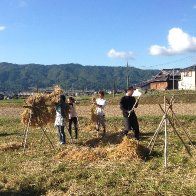
Recently Rated:
Stats
images: 1
Location: Matsusaka
Work interests:
Affiliation/website:
Preferred contact method: Reply to post in blog/forum/group
Preferred contact language(s):
Contact:
Favourite publications:
Work interests:
Affiliation/website:
Preferred contact method: Reply to post in blog/forum/group
Preferred contact language(s):
Contact:
Favourite publications:
Founding Member
Location: Mie, Japan
Work: Traditional agriculture, agroforestry, and land management. Ethnoecology issues relating to vulnerable or transient groups. Ethnoecology issues in East Asia, South America, and East Africa. Biodiversity and nutrition, etc.
Biographical: I recently conducted research on the use of wild, edible plants in Mie, Japan and plan to continue working in East Asia. My native tongue is English but I can correspond in Spanish and Japanese and have a very basic knowledge of Swahili and Korean.
Favourite Publications: The Organic Farmer Magazine (East Africa) The African Journal of Food, Agriculture, Nutrition and Development
Work: Traditional agriculture, agroforestry, and land management. Ethnoecology issues relating to vulnerable or transient groups. Ethnoecology issues in East Asia, South America, and East Africa. Biodiversity and nutrition, etc.
Biographical: I recently conducted research on the use of wild, edible plants in Mie, Japan and plan to continue working in East Asia. My native tongue is English but I can correspond in Spanish and Japanese and have a very basic knowledge of Swahili and Korean.
Favourite Publications: The Organic Farmer Magazine (East Africa) The African Journal of Food, Agriculture, Nutrition and Development


Hi. Check your mail I have send the final paper to you. Please have a look. Used your Utah address
Further to my first note... Japanese archaeobotany is a rich field, and there are many discoveries that can be related to vegetation history and ethnobotanical records of plant use and landscape management. Japanese archaeology is not so conventionally spectacular as in other areas of East Asia, but it is ubiquitous in the landscape, and there are vast troves of untranslated and minimally interpreted archaeological site reports.
Dear Julia,
Thanks very much for joining. If you would like to gain more visibility for your offer of help with editing, please use our forum for editing offers, here:
http://researchcooperative.org/forum/categories/editing-offers
You can also join our group for editors and proofreaders here:
The Research Cooperative - for better communication
Service offers and requests. Authors, editors, proofreaders, illustrators, indexers, translators. Academic,...
What I really would like is if we can somehow form a writing group to introduce Japanese archaeological landscapes through short leaflets in multiple languages, in order to kick start a major new direction for educational travel in Japan. The Japanese tourism industry seems to be completely blind to the economic potential of archaeological heritage in this country, and has little idea of how to present it to non-Japanese audiences.
Best regards, Peter